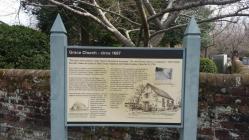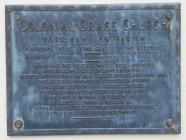Inscription
"The pews and windows of the Church all broke & destroyed. The church was used as a magazine." York County Records, Claims for Loses of York County Citizens in the British Invasion, Claim No. 31, 1783.
Grace Church, a religious centerpiece in Yorktown's history, has endured two wars, a devastating fire, and at times, the crumbling of "old age," while continuing to serve as a place of worship for over 300 years.
Constructed about 1697 for the York Parish of the Anglican Church, the official Church of England, the church was an integral part of the colonial community. Citizens were required to regularly attend services or face criminal prosecution. Additionally, religious events such as weddings, funerals, confirmations and Sunday services provide people with social opportunities.
In the aftermath of the American Revolution, Virginian's Anglican churches lost their government support. The churches struggled to survive while reorganization as the Protestant Episcopal Church in Virginia. The Yorktown congregation has additional challenges because the town's population had decreased over 60% as a result of the war.
The resiliency of the congregation was tested again in 1814 when a fire destroyed the church's roof and interior. For the next 34 years worship services were held in various locations, including the courthouse and the Nelson House. In 1847, Bishop John Johns wrote, "The stone walls of the old Church...are still standing. It is proposed to use them, in part, to provide a suitable place for our services." By the fall of 1848, the church has been rebuilt, utilizing the original walls. It became known as Grace Church for the first time.
Today, the congregation of Grace Church remains active in the Yorktown community, while the building continues to offer a link to Yorktown's colonial past.
(captions)
(lower left) A photograph of the church taken around 1900. In 1927, restoration work added new features to the church, including a Georgian doorway, front steps, a belfry,and colonial windows.
(upper right) A 1947 archeological excavation revealed the marl "bricks" in the churches foundation.
(lower right) A rendition of the church in the 18th century by W. Wildman, 1996. Courtesy of Grace Episcopal Church
Grace Church, a religious centerpiece in Yorktown's history, has endured two wars, a devastating fire, and at times, the crumbling of "old age," while continuing to serve as a place of worship for over 300 years.
Constructed about 1697 for the York Parish of the Anglican Church, the official Church of England, the church was an integral part of the colonial community. Citizens were required to regularly attend services or face criminal prosecution. Additionally, religious events such as weddings, funerals, confirmations and Sunday services provide people with social opportunities.
In the aftermath of the American Revolution, Virginian's Anglican churches lost their government support. The churches struggled to survive while reorganization as the Protestant Episcopal Church in Virginia. The Yorktown congregation has additional challenges because the town's population had decreased over 60% as a result of the war.
The resiliency of the congregation was tested again in 1814 when a fire destroyed the church's roof and interior. For the next 34 years worship services were held in various locations, including the courthouse and the Nelson House. In 1847, Bishop John Johns wrote, "The stone walls of the old Church...are still standing. It is proposed to use them, in part, to provide a suitable place for our services." By the fall of 1848, the church has been rebuilt, utilizing the original walls. It became known as Grace Church for the first time.
Today, the congregation of Grace Church remains active in the Yorktown community, while the building continues to offer a link to Yorktown's colonial past.
(captions)
(lower left) A photograph of the church taken around 1900. In 1927, restoration work added new features to the church, including a Georgian doorway, front steps, a belfry,and colonial windows.
(upper right) A 1947 archeological excavation revealed the marl "bricks" in the churches foundation.
(lower right) A rendition of the church in the 18th century by W. Wildman, 1996. Courtesy of Grace Episcopal Church
Details
| HM Number | HM1ILQ |
|---|---|
| Tags | |
| Marker Condition | No reports yet |
| Date Added | Thursday, January 1st, 2015 at 1:01am PST -08:00 |
Pictures
Locationbig map
| UTM (WGS84 Datum) | 18S E 366238 N 4122094 |
|---|---|
| Decimal Degrees | 37.23578333, -76.50796667 |
| Degrees and Decimal Minutes | N 37° 14.147', W 76° 30.478' |
| Degrees, Minutes and Seconds | 37° 14' 8.82" N, 76° 30' 28.68" W |
| Driving Directions | Google Maps |
| Area Code(s) | 757 |
| Which side of the road? | Marker is on the right when traveling North |
| Closest Postal Address | At or near 115 Church St, Yorktown VA 23690, US |
| Alternative Maps | Google Maps, MapQuest, Bing Maps, Yahoo Maps, MSR Maps, OpenCycleMap, MyTopo Maps, OpenStreetMap |
Is this marker missing? Are the coordinates wrong? Do you have additional information that you would like to share with us? If so, check in.
Nearby Markersshow on map
Maintenance Issues
- Is this marker part of a series?
- What historical period does the marker represent?
- What historical place does the marker represent?
- What type of marker is it?
- What class is the marker?
- What style is the marker?
- Does the marker have a number?
- What year was the marker erected?
- Who or what organization placed the marker?
- Can this marker be seen from the road?
- Is the marker in the median?



Comments 0 comments